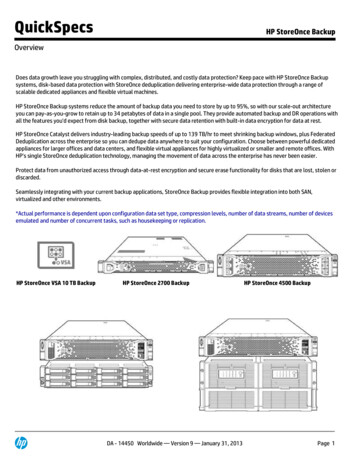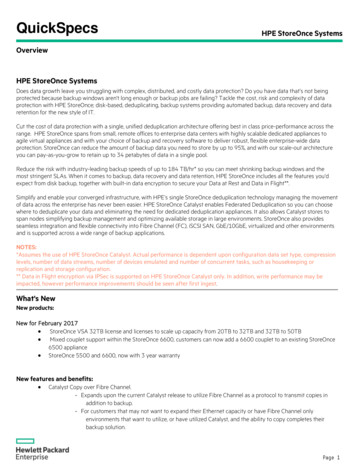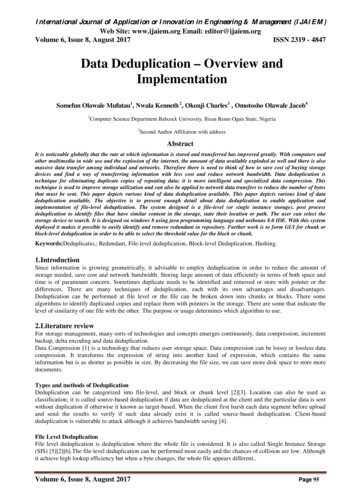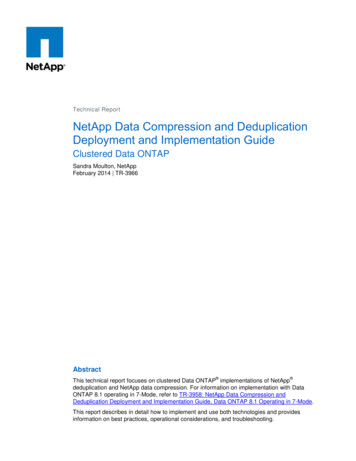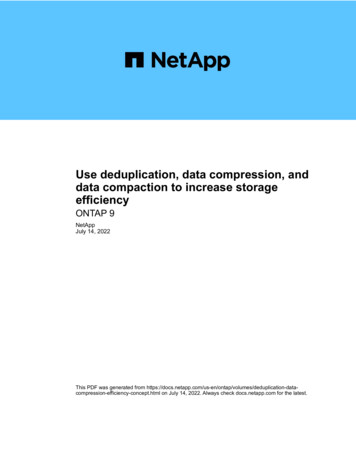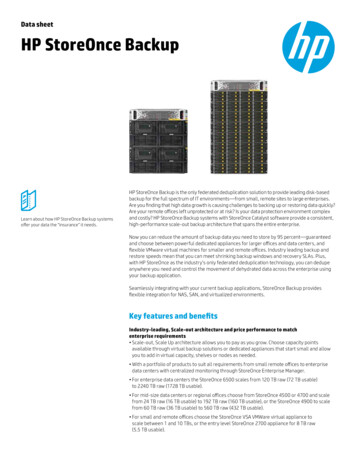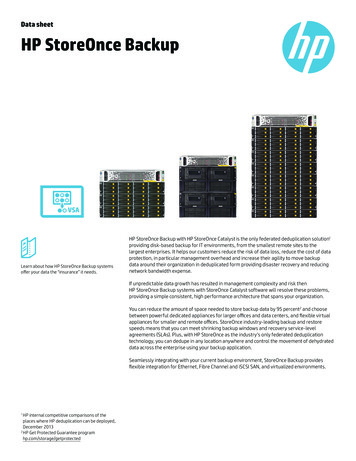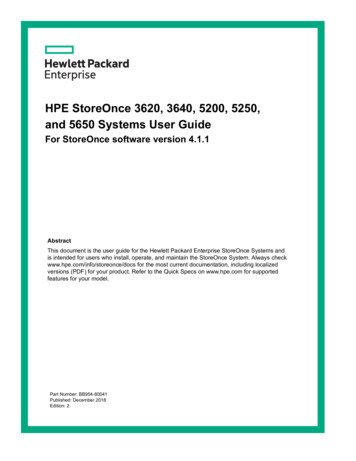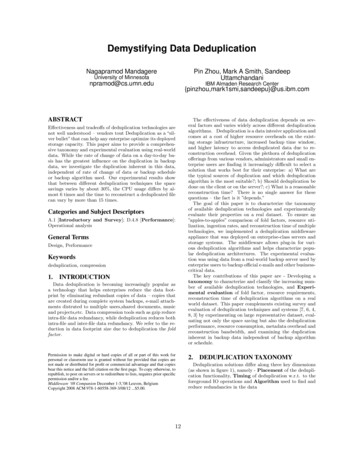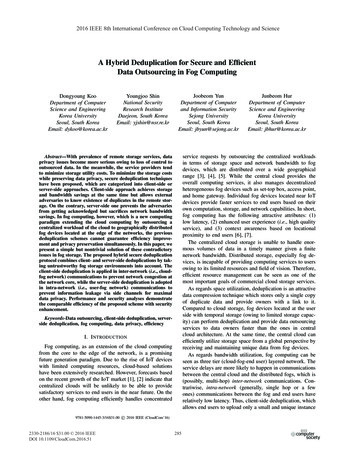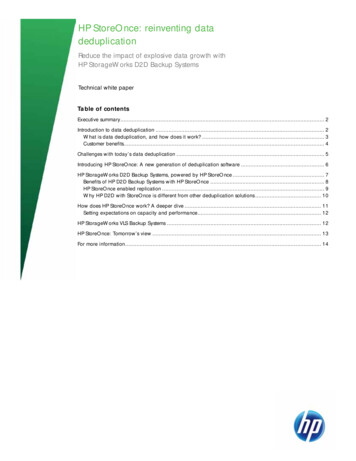
Transcription
HP StoreOnce: reinventing datadeduplicationReduce the impact of explosive data growth withHP StorageWorks D2D Backup SystemsTechnical white paperTable of contentsExecutive summary. 2Introduction to data deduplication . 2What is data deduplication, and how does it work? . 3Customer benefits. 4Challenges with today’s data deduplication . 5Introducing HP StoreOnce: A new generation of deduplication software . 6HP StorageWorks D2D Backup Systems, powered by HP StoreOnce . 7Benefits of HP D2D Backup Systems with HP StoreOnce . 8HP StoreOnce enabled replication . 9Why HP D2D with StoreOnce is different from other deduplication solutions . 10How does HP StoreOnce work? A deeper dive . 11Setting expectations on capacity and performance. 12HP StorageWorks VLS Backup Systems . 12HP StoreOnce: Tomorrow’s view . 13For more information . 14
Executive summaryRather than spending IT dollars on infrastructure and overheads, today’s businesses need their ITdollars to go toward delivering new applications to help them to be more competitive in the businessthey're in, help them enter new businesses, and to support business transformation. Businesseseverywhere are counting on IT to deliver more value to their business. HP believes that IT has theresources to do it. The problem is, because of the sprawl of data and systems, those resources aretangled up in the overheads of legacy architectures and inflexible stacks of IT.Data explosion is a primary contributor to IT sprawl, inefficiency, and waste. The data growthchallenge is particularly acute when looking at how much time and money customers spend inmanaging data protection processes and the ever growing mountain of archival and offline data. Thedigital data universe grew to 800 billion gigabytes in 2009, an increase of 62 percent from the2008 figures, and it doesn’t stop there; the digital data universe is expected to grow by 44 timesbetween 2010 and 2020. 1 It’s no surprise then, that a 2010 Storage Priorities Survey 2 reported thatEnterprise storage managers list two of their three top storage priorities to be related to dataprotection; namely data backup and disaster recovery. Data deduplication continues to be the likeliestnew technology to be added to backup operations, with 61 percent of customers in the storagepriorities survey either deploying or evaluating it, and that’s on top of the 23 percent of currentdeduplication users.Data deduplication has emerged as one of the fastest growing datacenter technologies in recentyears. With the ability to decrease redundancy and so retain typically 20x more data on disk, itcontinues to attract tremendous interest in response to data growth. However, implementations of firstgenerations of deduplication technology have become extremely complex, with numerous pointsolutions, rigid solution stacks, scalability limitations, and fragmented heterogeneous approaches. Thiscomplexity results in increased risk, extra cost, and management overhead.This whitepaper introduces and describes StoreOnce software, next-generation deduplicationtechnology from HP that allows for better management, higher performance, and more efficient dataprotection, while providing IT administrators with a cost-effective way to control unrelenting datagrowth.Introduction to data deduplicationIn recent years, disk-based backup appliances have become the backbone of a modern dataprotection strategy because they offer: Improved backup performance in a SAN environment with multi-streaming capabilities Faster single file restores than physical tape Seamless integration into an existing backup strategy, making them cost-effective and low risk The option to migrate data to physical tape for off-site disaster recovery or for long-term energy andcost-efficient archiving Optimized data storage through data deduplication technology, which enables more networkefficient data replication122IDC study “The Digital Universe Decade – Are You Ready?” May 2010.searchstorage.com March 2010.
Figure 1: HP is reinventing deduplication with HP StoreOnceProblem:Ø Complex, incompatible deduplication solutionsØ Limited scalability and flexibilityØ Extra time and cost for backupsSolution:Ø HP StoreOnce deduplicationØ Single deduplicationengine across the enterpriseBenefits:Ø Up to 20% faster performanceØ Up to twice the price/performanceØ One deduplication approach for unified managementWhat is data deduplication, and how does it work?Data deduplication is a method of reducing storage needs by reducing redundant data, so that overtime only one unique instance of the data is actually retained on disk. Data deduplication works byexamining the data stream as it arrives at the storage appliance, checking for blocks of data that areidentical, and removing redundant copies. If duplicate data is found, a pointer is established to theoriginal set of data as opposed to actually storing the duplicate blocks—removing or “de-duplicating”the redundant blocks from the volume (See Figure 2). However, indexing of all data is still retained sothat it can be “rehydrated” should that data ever be required.The key here is that the data deduplication is being done at the block level to remove far moreredundant data than deduplication done at the file level (called single-instancing), where onlyduplicate files are removed.Figure 2: Illustrating the deduplication processBackup 1Backup 2Backup 3Backup 4Backup nUnique blocksstored on D2D3
As the backup process tends to generate a great deal of repetitive copies of data, and hence datadeduplication is especially powerful when it is applied to backup data sets. The amount ofredundancy depends on the type of data being backed up, the backup methodology and the lengthof time the data is retained.Once the original file is stored, the technology removes duplicate data down to the block or byte levelon all future changes to that file. If a change is made to the original file, then data deduplicationsaves only the block or blocks of data actually altered, (a block is usually quite small, less than 10 KBof data). For example, if the title of our 1 MB presentation is changed, data deduplication would saveonly the new title, usually in a 4 KB data block, with pointers back to the first iteration of the file. Thus,only 4 KB of new backup data is retained.When used in conjunction with other methods of data reduction such as conventional datacompression, data deduplication can cut data volume even further.Customer benefits Ability to store dramatically more data online (online means disk based): Retaining more backupdata on disk for longer duration enables greater data accessibility for rapid restore of lost orcorrupt files, and reduces impact on business productivity while providing savings in IT resource,physical space, and power requirements. Disk recovery of single files is faster than tape. An increase in the range of Recovery Point Objectives (RPOs) available: Data can be recovered fromfurther back in time from earlier backup sets to better meet Service Level Agreements (SLAs). A reduction of investment in physical tape: This consequently reduces the overheads of tapemanagement, by restricting the use of tape to more of deep archiving and disaster recovery usagemodel. A network efficient way to replicate data offsite: Deduplication can automate the disaster recoveryprocess by providing the ability to perform site-to-site replication at a lower cost. Becausededuplication knows what data has changed at the block or byte level, replication becomes moreintelligent and it transfers only the changed data as opposed to the complete data set. This savestime and replication bandwidth, enabling better disaster tolerance without the need andoperational costs associated with transporting data off-site on physical tape.4
Challenges with today’s data deduplicationFirst-generation deduplication has proven valuable in terms of data reduction; however, initialimplementations have become extremely complex with point solutions, rigid solution stacks, scalabilitylimitations, and fragmented heterogeneous approaches. This complexity results in increased risk, extracost, and management overhead (as illustrated in Figure 3).Figure 3: Today’s data deduplication infrastructure–complex and fragmentedData movement between systems requiresprocessing through different deduplicationRehydrated dataDataRehydrated dataComplexprovisioningRemote officeRegional siteData centerProliferatedmanagementInefficient datamovementTechnology ADeduplicated dataTechnology BDeduplicated dataTechnology CDeduplicated dataIn this illustration (Figure 3), the data is deduplicated at the remote office, regional site, and datacenter. However, it must be rehydrated (also referred to as re-inflated or reduplicated) at each stagein order to be passed between incompatible deduplication technologies.First-generation deduplication solutions were designed for either backup or primary storage, withoutreally being optimized for both applications and suffered from the following issues:Complex, incompatible backup solutions Fragmented, mixed-technology approaches to backup that have not been designed for aConverged Infrastructure that moves data and applications together Incompatible technologies in remote, regional, and central offices Multiple expansion and contraction cycles required when moving data from system to system, thatis, data must be deduplicated and then rehydratedLimited scalability and flexibility Lack of scalability across an enterprise, scaling is reliant on specific client-side backup software Tightly controlled, closed deduplication architectures5
Different optimizations for different application types, that is, solutions are not application agnosticand require a great deal of tuning for certain applications to function properly Rigid solution stacks that inhibit innovation and complicate new hardware deployments, forexample, primary deduplication solutions are not effective across multiple isolated nodesExtra time and cost for backups Long backup and recovery times Multiple expansion/contraction cycles required when moving data from system to system More data sets to backup, more management burdens on IT administratorsIt’s our vision that data should be created, shared, and protected without being deduplicated andrehydrated (rededuplicated) multiple times along the way. Simply “StoreOnce” and that’s it.Introducing HP StoreOnce: A new generation ofdeduplication softwareHP StoreOnce deduplication is a new class of software that leverages HP Labs technology innovationsto deliver a more efficient way to accommodate data growth, without adding cost or reducingperformance.Figure 4: HP StoreOnce provides the same software solution from end-to-end.CommoninfrastructureBackupsoftwareD2D systemConsolidatedmanagementHPStoreOnceFlexible datamovementRemote officeVirtual machinesWANServersVM VMVM VMScale-outenterprise storageApplication serversData centerD2D systemRegional office6
HP StoreOnce deduplication can be used in multiple places in the data center. The advantage is thatthe same technology allows you to move/backup/access data without having to “rehydrate” the databefore moving it to another point.HP StoreOnce deduplication software delivers improved performance at half the price point ofcompetitive solutions and enables clients to spend up to 95 percent less 3 on storage capacitycompared to traditional backup. 4 HP StoreOnce software helps clients to enhance: Performance—Fast, efficient algorithms enable users to achieve 20 percent faster inlinededuplication and twice the price/performance over competitive offerings through smart data andindex layout capabilities that reduce disk utilization and increase input/output (I/O) efficiency. 5 Scalability—From small remote office to enterprise data center, the ability to support more storagefor the same amount of CPU and memory. Simplify management and improve data protection byproviding the ability to centrally run multiple backup sites and easily replicate data from remoteoffices to data centers. Efficiency—Smallest chunk size on the market means better, more resilient deduplication to datatypes and formats, as well as the ability to deduplicate data from adjacent use cases. This allowsusers to create, share, and protect their data without having to deduplicate multiple times.HP StoreOnce software is available in all HP StorageWorks D2D Backup Systems from July 2010,providing a single technology that can be deployed at multiple points in a Converged Infrastructure.Previous generation D2D products soon may be able to upgrade to a 32 bit StoreOnce code streamallowing both generations to replicate between each other.HP StorageWorks D2D Backup Systems, powered by HPStoreOnceThe HP StorageWorks D2D Backup Systems provide disk-based data protection for data centers andremote offices. Using HP D2D, IT or storage managers can automate and consolidate the backup ofmultiple servers onto a single, rack-mountable device while improving reliability by reducing errorscaused by media handling. The D2D Backup Systems integrate seamlessly into existing ITenvironments and offer the flexibility of both NAS (CIFS/NFS) and Virtual Tape Library (VTL) targets 6.All HP D2D Backup Systems feature HP StoreOnce deduplication software for efficient, longer-termdata retention on disk and enabling network-efficient replication for a cost-effective way oftransmitting data offsite for disaster recovery purposes.3456Based on multi-site deployment of D2D4312 ROI calculations as replacement technology for pure tape backup and offsite archival (HP D2DTCO Analysis from May 2010).Based on average deduplication ratio of 20:1. Deduplication ratio could be as high as 50:1 under optimal circumstances.Based on comparison to competitive systems using standard interfaces for all backup apps FC, CIFS, and NFS interfaces.Earlier generations of D2D (before June 2010) only support NAS (CIFS) and virtual tape library (VTL) targets.7
Figure 5: HP StorageWorks D2D Backup 500Series Entry-level choice of 1.5and 3 TBs usable4.5 to 9 TBsusable withupgrade9 to 18 TBsusable withupgrade Leading capacityScalable to 36 TBsusableBenefits of HP D2D Backup Systems with HP StoreOnceIn addition to the benefits of disk-based backup, automation, and consolidation of multi-server backupto a single D2D appliance with HP StoreOnce deduplication, the HP StorageWorks D2D BackupSystems also provide the opportunity to:Enhance business performance Get 20 percent faster in-line deduplication performance with innovations from HP Labs includingsmart data and index layout capabilities that reduce disk utilization and increase I/O efficiency. 7 Improve backup and recovery times with industry-leading in-line disk-based replication to improvebusiness performance and reduce the impact of explosive data growth. Achieve throughput of up to 2.5 terabytes of data per hour and per node with HP D2D4312Backup Systems.Lower operational costs and maintain compliance Achieve up to twice the price/performance of competitive technologies—based on HP performanceand pricing comparisons. Spend up to 95 percent less on new capacity 8 and reinvest in business innovation. Store more backup data on disk for longer periods of time, and access data rapidly when neededfor compliance purposes. Accelerate backup and recovery time while cutting your total business protection costs. Increaseefficiency by allowing clients to create, share, and protect their data without having to“deduplicate” multiple times. Leverage a solution that outperforms competitive offerings in a real-world scenario.788Based on comparison to competitive systems using standard interfaces for all backup apps FC, CIFS, and NFS interfaces.Based on multi-site deployment of D2D4312 ROI calculations as replacement technology for pure tape backup and offsite archival (HP D2DTCO Analysis from May 2010).
Improve business continuity and gain affordable data protection for ROBO sites Improve business continuity by providing cost-efficient replication of data across the storagenetwork to an offsite location for disaster recovery purposes. Manage all local and remote backup with multi-site replication management. Simplify management overhead with a deduplication platform that’s easy to deploy and use. Maintain remote systems cost-effectively with HP Integrated Lights-Out management (iLO) andintegration with HP System Insight Manager.HP StoreOnce enabled replicationData replication is the process of making a replica copy of a data set across a network to a “targetsite”. It is generally used to transmit backup data sets off-site to provide disaster recovery (DR)protection in the event of catastrophic data loss at the “source site.”Figure 6: HP StoreOnce enabled data replication—affordable disaster recovery for ROBO sitesMain locationReplication to targetD2D backup systemRemote officesHP D2D backup system ateach siteIn the past, only large companies could afford to implement data replication as replicating largevolumes of data backup over a typical WAN is expensive. However, because StoreOncededuplication knows what data has changed at the block or byte level, replication becomes moreintelligent and transfers only the changed data as opposed to the complete data set. This saves timeand replication bandwidth making it possible to replicate data over lower bandwidth links for a morecost-effective, network-efficient replication solution. HP D2D Backup Systems with StoreOnce providean automated and practical disaster recovery solution for a wide range of data centers, in addition tobeing an ideal solution for centralizing the backup of multiple remote offices.9
Figure 7: Benefits of HP StoreOnce enabled replicationRemote site 1Backup hostsChanged data replicatedfrom remote sites to maindata center via WANRemote site 2Backup hostsHead office data centerSANSANRemote site 3Backup hostsSANSeveralmonthsRemote site nseveral monthsBackup hostsPeriodictape copySANseveral monthsSANseveral monthsDeduplicated data ondisk extended toseveral monthsAutomated backup – nooperators required at remotesites to manage tapesOffsite tape vaultseveral monthsMulti-year archivalData replication from HP features the ability to limit the replication bandwidth used for even morenetwork-efficient replication. Without this ability, a replication job would use as much bandwidth as isavailable, potentially making other network activities unresponsive. Replication bandwidth limiting iscustomer-configurable at the appliance level via the graphical user interface and is set as apercentage of the available network bandwidth.All HP D2D Backup Systems are available with an option to license data replication by target device.Note that HP D2D Replication Manager software is included with the license to provide an easierway to manage a large number of devices being replicated to a central site. HP OST plug-in installedon Media Servers and Symantec backup applications (i.e. Backup Exec or NetBackup) have thevisibility to replicate copies of backups on remote D2D Backup Systems.Why HP D2D with StoreOnce is different from other deduplicationsolutionsWhile competitors have unwittingly engineered complexity into their deduplication solution, HP hassimplified the process and enabled 2x 9 the price/performance of competing solutions. HP StoreOncededuplication software includes technology innovations from HP Labs: HP StoreOnce software uses the smallest data block sizes in the industry to deliver applicationindependence. This removes the need to maintain specific application optimizations and reducesapplication scaling issues that result from having multiple optimizations for different applicationtypes.910Evaluator Group independently tested and verified the HP 20% performance advantage and 2X price-performance claim. This was based on performancecomparison to competitive systems using FC, VTL, and CIFS interfaces conducted in May 2010 and standard published pricing as of April 2010.
Locality sampling and sparse indexing significantly lowers RAM requirements without sacrificingquality, it’s like having a GPS for data deduplication. Intelligent data matching enables HP D2D to perform optimally for multiple data types and backupsoftware deployments with no added complexity. Optimized data chunking results in minimal fragmentation compared to the competition, whichreduces ongoing management overhead and speeds up restore time.The result is a single unified architecture and a single deduplication software engine built on HPConverged Infrastructure. This extensible solution enables HP to deploy StoreOnce-based solutionsfrom client to enterprise scale-out, enabling common management, and faster integration of newtechnologies.How does HP StoreOnce work? A deeper diveHP StoreOnce software works by using hash-based chunking techniques for data reduction. Hashingworks by applying an algorithm to a specific chunk of data and yielding a unique fingerprint of thatdata. The backup stream is broken down into a series of chunks. For example, a 4K chunk in a datastream can be “hashed” so it is uniquely represented by a 20-byte hash code; a massive order ofmagnitude reduction.The larger the chunks, the less chance there is of finding an identical chunk that generates the samehash code, and thus the deduplication ratio may not be as high. The smaller the chunk size, the moreefficient the data deduplication processes but greater indexing overhead.HP StoreOnce follows a straightforward process:1. As the backup data enters the target device (in this case the HP D2D2500, D2D41XX, orD2D4300 Series Backup Systems); it is chunked into a series of average 4K size chunks againstwhich the SHA-1 hashing algorithm is run. Batches of thousands of these chunks are deduplicatedat a time.2. A small number of chunks are sampled from each batch and then looked up (via their hash) in asmall in-RAM sparse index. The index maps each sampled chunk to previously backed up sectionsof data containing that chunk. Because the index needs to map only the sampled chunks, not allchunks, it can be two orders of magnitude smaller than some alternative technologies.3. Using the results from the index, HP StoreOnce chooses a small number of previously backed upsections that are highly similar to the new batch of data and deduplicates the new batch againstonly those sections. It does this by loading hash lists of the chunks in each section and comparingto see if any of them match the hashes of the chunks in the new batch.4. Chunks without matching hashes are written to the deduplication store and their hashes are alsostored as entries in a recipe file. The recipe represents the backup stream and it points to thelocations in the deduplication store where the original chunks are stored. This happens in real timeas the backup is taking place. If the data is unique (that is, a first time store), the HP D2D uses theLempel-Ziv (LZ) data compression algorithm to compress the data after the deduplication process,and before storing it to disk. Typical compression ratios are between 1.5:1 and 2:1, but may behigher depending on the data type.5. Chunks whose hash matches duplicate are not written to the deduplication store. An entry with thechunk's hash value is simply added to the “recipe file” for that backup stream pointing to thepreviously stored data, so space is saved. As you scale this up over many backups, there aremany instances of the same hash value being generated. However, the actual data is only storedonce, so the space savings increase.11
6. To restore data from the backup system, the D2D device selects the correct recipe file and startssequentially re-assembling the file to restore. It reads the recipe file, getting original chunks fromdisk using the information in the recipe, and returns the data to the restore stream.7. Chunks are kept until no recipe refers to them (for example, the backups containing them havebeen deleted), then they are automatically removed in a housekeeping operation.Most deduplication technologies in existence today use hash-based chunking. However, they oftenface issues with the growth of indexes and the amount of RAM storage required to store them. Forexample, a 1 TB backup data stream using 4K chunks results in 250 million 20-byte hash valuesrequiring 5 GB of storage. If the index management is not efficient, this can significantly slow thebackup down to unacceptable levels or require a great deal of expensive RAM.By comparison, HP StoreOnce with HP Labs innovation dramatically reduces the amount of memoryrequired for managing the index without noticeably sacrificing performance or deduplicationefficiency. Not only does this technology enable low-cost high performance disk backup systems, butit also allows the use of smaller chunk sizes. This produces more effective data deduplication that ismore robust to variations in backup stream formats or data types.Setting expectations on capacity and performanceIn terms of how much more data can be stored with HP StoreOnce and D2D Backup Systems, thesimple answer is that you can expect to see a reduction in the amount of data typically by 20x.However, this is dependent on the nature of the data being backed up, the backup methodology, andthe length of time that the data is retained. With the backup of a typical business data set over aperiod of more than 3 months, users might expect to see a deduplication ratio of 20:1 for dailyincremental and weekly full backups, or more for daily full backups.Performance is highly dependent upon specific environments, configuration, type of data, and the HPD2D Backup System model that is chosen.For more detailed and specific advice, we recommend that you use the HP sizer tool at:www.hp.com/go/storageworks/sizerA best practices whitepaper can also help with performance tuning for the HP D2D Backup System—refer to: ame 4AA2-7710ENW.pdfHP StorageWorks VLS Backup SystemsThe VLS product family with its accelerated deduplication capabilities continues to be an importantpart of the portfolio for large enterprise customers backing up to disk over a Fibre Channel SAN. HPis continuing to invest in this solution with improvements in performance and capacity. That said, theD2D product family with its improvements in performance and scalability aims to be the primarysolution for customers backing up over Ethernet via VTL, NAS, or OST with a common architecturefrom client to back-end and on both physical and virtual devices.12
HP StoreOnce: Tomorrow’s viewHP StorageWorks continue to help clients build a Converged Infrastructure with virtualized storagesolutions that reduce IT sprawl and provide the operational flexibility to shift resources easily forimproved business productivity. HP StorageWorks is transforming data protection with HP StoreOnce,the next generation in deduplication software designed to provide unprecedented performance,simplicity, and efficiency while maintaining business continuity.Due to its modular design, future HP StoreOnce software can be extended across a number ofsolutions addressing different environments and deployments. One of these is as a virtual machineappliance providing flexibility to address environments too small for a dedicated appliance. Anotheris integrated with HP Data Protector Software, both as a software deduplication target store, as wellas an option to employ deduplication on the client, reducing data sent over the network to the source.Because HP StoreOnce has been designed to support distribution of deduplication across a multi-nodesystem, it can be integrated with the HP file system technology in the X9000 to provide a scale-outstorage system for the enterprise for backup and archive data.Through all this, the HP StoreOnce portfolio maintains compatibility between the variousimplementations. This allows customers to mix and match StoreOnce solutions, whether hardwareversus software, target versus client-side, or remote office versus enterprise implementations. The endresult enables a major step towards simplified management and flexible data movement across theenterprise.Figure 8: Extending the technology—modular architecture enables flexible deployment and gVTLVirtual machineNASHPHPStoreStoreOnceOnceMgmtServersFile SystemHPStoreOnceRAIDVM VMVM VMD2D BackupSystemsHP Data protectorHPStoreOnceClientBackup &archiveHPStoreOnceHPStoreOnceHPStoreOnceBackup serverScale-ou
HP StoreOnce software is available in all HP StorageWorks D2D Backup Systems from July 2010, providing a single technology that can be deployed at multiple points in a Converged Infrastructure. Previous generation D2D products soon may be able to upgrade to a 32 bit StoreOnce code stream
